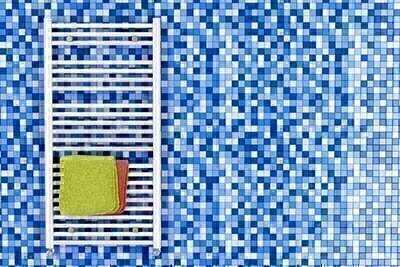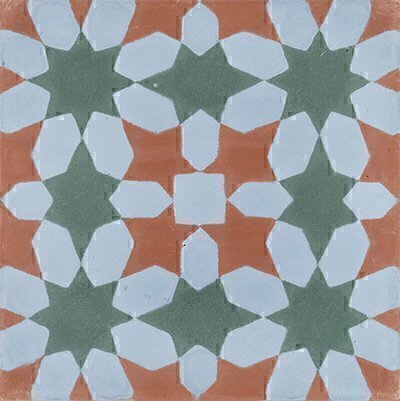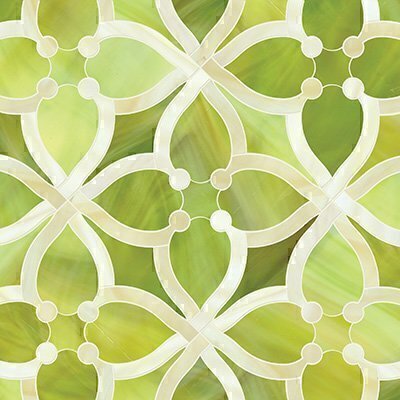Tips on Choosing Tiles
Last updated September 2024
Life at home can get messy. Prepping dinner (and washing dishes after) could plaster your kitchen counters and floor with water, stray sauce, or random gunk. Bathrooms somehow wind up looking like crime scenes after kids brush their teeth and perform other simple tasks. That’s why many homeowners use tile to cover floors, backsplashes, and even countertops in high-traffic, high-use areas.
It’s waterproof, easy to clean, and comes in a range of materials and styles, from contemporary cool ceramic in hexagon shapes to marble mosaics worthy of a Greek temple.
But walk into a tile showroom or home improvement store and you may be overwhelmed with options. Cement or porcelain? White or off-white subway tiles? Glass tiles etched and painted with songbirds?
Here are tips on making all these hard decisions easier.
Many tiles are made from clay that has been shaped and dried, then fired in a kiln at very high temperatures to make them hard. To get a glossy finish, tiles can be glazed and fired again. Unfinished tiles are also sold, but they come in a limited range of colors. Other tiles are made of natural stone: marble, travertine, limestone, etc.
 Durability
Durability
For walls, floors, or countertops, you don’t want tile that’s too easily scratched or permeable. For example, those frosted-green glass tiles may look gorgeous, but you may want to save them for a backsplash, not a high-traffic floor where they are likely to crack. Marble boasts classic shine and luminosity, but it can stain and crumble if it’s installed on kitchen counters.
Most boxes of tile are labeled according to their best usages, and staffers at good tile stores can also advise you on which types fit certain spots. The Porcelain Enamel Institute (PEI) has a guide that rates tiles on a traffic-ready scale of 1 to 5, with PEI 1 tiles (e.g., an etched glass tile) recommended only for indoor wall usage to PEI 5 tiles, which are extremely durable and can withstand outdoor elements and industrial settings.
Material Whirl
What your tile is made of is largely a matter of personal preference and budget. Crave a sleek contemporary look? Consider larger slab-style marble tiles for a bathroom wall and floor. Trying for a rustic-style kitchen? Encaustic (cement) tiles in a Med-cool print could summon a welcoming vibe. You can even find leather and metal tiles, though the former are best suited for library and office walls, not floors or areas that get damp.
Keep It Current or Classic
Tile styles, like other household finishes, change quickly these days. If you’re planning on selling your home in the next five years or so, it’s best to use a style that’s currently popular.
Retro subway tiles (rectangles, often in white) and penny mosaic tiles remain popular. There’s also a Millennial- and Zennial-powered trend for all things 1970s and 1980s. Contemporary styles include four-inch hexagons in marble or jumbo-sized rectangles (18 by 36 inches!) meant to mimic wood plank floors. Square tiles are edging back into fashion, either in standard styles or Moroccan zelliges, which have an appealing uneven handmade quality. If your taste leans toward traditional, or you live in a historic house, sticking to tried-and-true styles (think what you’d find in Great-Grandma’s bathroom circa 1920), like black-and-white basket-weave styles, or, yep, subway tiles.
 Set a Budget
Set a Budget
You can spend a lot on tile (some mosaic styles at haute showroom Ann Sacks cost over $100/sq. ft.) or a little (subway tiles can run as little as $1.50/sq. ft. at Home Depot). Many inexpensive tiles look terrific when installed well; some expensive styles (mosaics, rare marbles) might be worth it in smaller areas or if you really want a design punch.
Slip-Sliding Ways
Some floor tiles get slippery when wet (a potentially dangerous issue in kitchens and bathrooms). Untreated marble styles can be particularly treacherous, and the larger the size of your tiles of any kind, the higher the chance they’ll make you go head over heels (in a bad way).
The industry uses two measurements for slipperiness: SCOF (Static Coefficient of Friction) and DCOF (Dynamic Coefficient of Friction). For floors, you’ll want a SCOF score of .6 or greater and a DCOF score of .42 or greater. Manufacturers also usually specify whether products are suitable for floors. Using smaller tiles is also a good way to combat slick surfaces—more surface area is covered in grout, which increases grip.
Considering Color
Tiles come in as many colors as Crayolas now. If you like bright red or neon green, you can get that. But before you go with an all-hot-pink bathroom, think about whether you’ll tire of its Legally Blonde vibe in five or 10 years. Classic hues—whites, grayish veined marble, black-and-white basket weaves—have longer shelf lives. Much like in fashion, mixing neutrals and brights can have a dramatic effect: You might pair gray marble floors in a kitchen with a rainbow-colored Mexican-tile backsplash.
Size Matters
Scale matters, too. Smaller tiles—2- x 3-inch subway styles or penny tiles—can create a lovely effect in a wee powder room. In a larger space, say a basement den, large wood-look tiles could mimic wide oak flooring.
There’s a Match for That
You can tile a whole kitchen or bathroom in one style of tile. And it’s currently cool and minimalist to use so-called slab tiles—oversized rectangles or squares (e.g., a 24- by 24-inch marble rectangle) to get a sleek modern look on both the wall and floor, particularly in the loo. But mixing your materials—diamond-shaped tiles in gray on the kitchen floor, marble subway tiles in a herringbone pattern on the backsplash—adds visual interest and panache. When combining tiles like this, it’s helpful to think of what would make a nice contrast, say a scalloped fish scale-style floor and square tiles on the wall in a bathroom. In general, if you’re using a special-shaped tile—a hexagon, a diamond, a penny tile—on one surface, you want to stick with a simpler square or rectangle on other surfaces in the room.
 Grout Options
Grout Options
Color is your choice; the installer usually picks the type. The most common is sanded Portland cement, used on most tiles with joints over 1/8-inch wide. It takes about 24 hours to dry, becomes hard like concrete, but remains porous unless sealed, even with latex additives. Some manufacturers add anti-fungal and mildew-resistance agents, which can help in wet areas. Non-sanded grout is generally used for joints under 1/8-inch wide and on easily scratched tiles such as polished marble (sanded grout swept across the floor will scratch and dull its surface). Epoxy resin, which doesn’t need sealing, is the best grout but not often used. It contains epoxy resins and a hardener, which makes it highly resistant to stains, mildew, and water. But epoxy is expensive and difficult to install.
You’d Better Shop Around
When you zero in on a type of tile, be sure to check at least three sources on pricing. We found prices ranging from less than $2 per square foot to more than $7 per square foot for the exact same 3- x 6-inch subway tiles.
Buy Extra
Most types of tile are rugged, but save a few extra pieces and some grout mix just in case you need replacements.


